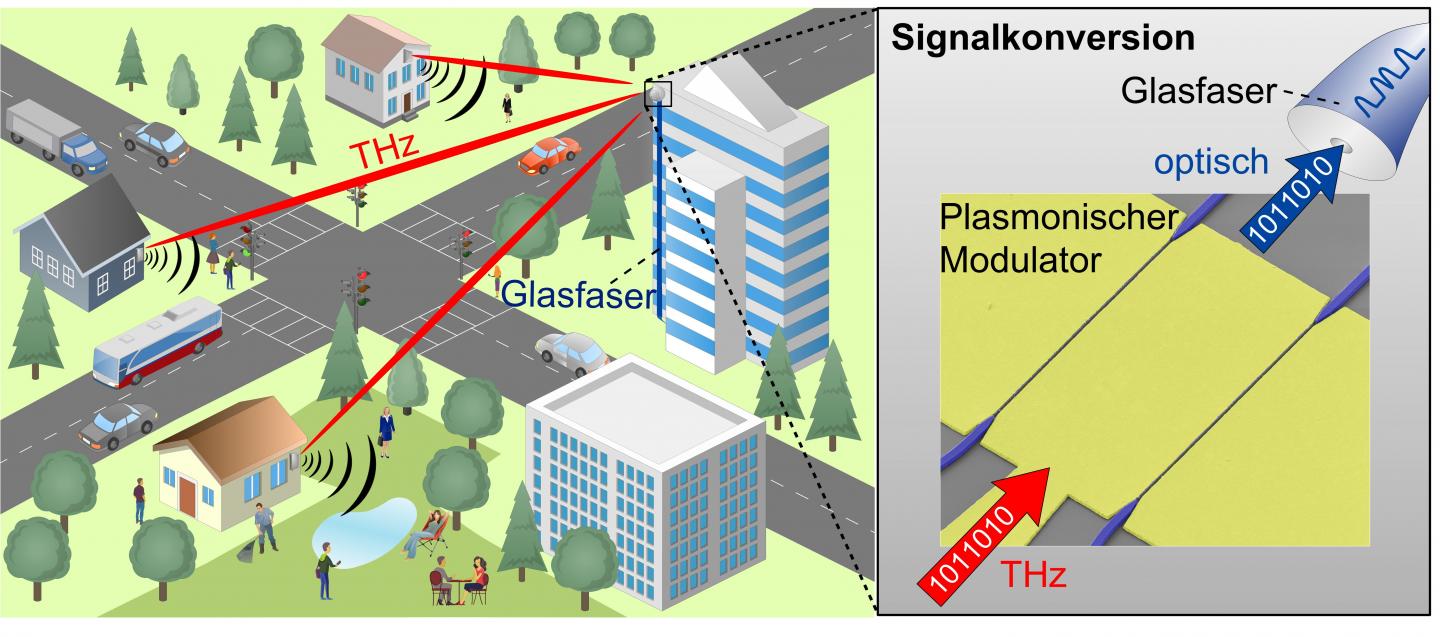Ultra-rapid Electro-optical Modulators Convert Terahertz into Optical Data Signals – Publication in Nature Photonics

Credit: IPQ/KIT
Future wireless data networks will have to reach higher transmission rates and shorter delays, while supplying an increasing number of end devices. For this purpose, network structures consisting of many small radio cells will be required. To connect these cells, high-performance transmission lines at high frequencies up to the terahertz range will be needed. Moreover, seamless connection to glass fiber networks must be ensured, if possible. Researchers of Karlsruhe Institute of Technology (KIT) use ultra-rapid electro-optical modulators to convert terahertz data signals into optical signals. This is reported in Nature Photonics (DOI: 10.1038/s41566-019-0475-6).
While the new 5G cellular network technology is still tested, researchers are already working on technologies for the next generation of wireless data transmission. “6G” is to reach far higher transmission rates, shorter delays, and an increased device density, with artificial intelligence being integrated. On the way towards the sixth generation cellular network, many challenges have to be mastered regarding both individual components and their interaction. Future wireless networks will consist of a number of small radio cells to quickly and efficiently transmit large data volumes. These cells will be connected by transmission lines, which can handle tens or even hundreds of gigabits per second per link. The necessary frequencies are in the terahertz range, i.e. between microwaves and infrared radiation in the electromagnetic spectrum. In addition, wireless transmission paths have to be seamlessly connected to glass fiber networks. In this way, the advantages of both technologies, i.e. high capacity and reliability as well as mobility and flexibility, will be combined.
Scientists of the KIT Institutes of Photonics and Quantum Electronics (IPQ), Microstructure Technology (IMT), and Radio Frequency Engineering and Electronics (IHE) and the Fraunhofer Institute for Applied Solid State Physics IAF, Freiburg, have now developed a promising approach to converting data streams between the terahertz and optical domains. As reported in Nature Photonics, they use ultra-rapid electro-optical modulators to directly convert a terahertz data signal into an optical signal and to directly couple the receiver antenna to a glass fiber. In their experiment, the scientists selected a carrier frequency of about 0.29 THz and reached a transmission rate of 50 Gbit/s. “The modulator is based on a plasmonic nanostructure and has a bandwidth of more than 0.36 THz,” says Professor Christian Koos, Head of IPQ and Member of the Board of Directors of IMT. “Our results reveal the great potential of nanophotonic components for ultra-rapid signal processing.” The concept demonstrated by the researchers will considerably reduce technical complexity of future radio base stations and enable terahertz connections with very high data rates – several hundred gigabits per second are feasible.
Figure:
Seamless integration of wireless links into fiber-optical networks is the key to high-performance data networks: future cellular networks will consist of many small radio cells that can be connected flexibly by high-performance THz transmission links. At the receiver, THz signals can be converted directly into optical signals with the help of ultra-rapid plasmonic modulators and transmitted via glass fiber networks.
###
Original Publication:
S. Ummethala, T. Harter, K. Koehnle, Z. Li, S. Muehlbrandt, Y. Kutuvantavida, J. Kemal, J. Schaefer, A. Tessmann, S. K. Garlapati, A. Bacher, L. Hahn, M. Walther, T. Zwick, S. Randel, W. Freude, C. Koos: THz-to-Optical Conversion in Wireless Communications Using an Ultra-Broadband Plasmonic Modulator. Nature Photonics, 2019. DOI: 10.1038/s41566-019-0475-6
For the abstract, click https:/
More about the KIT Information · Systems · Technologies Center: http://www.
Press contact: Kosta Schinarakis, Redakteur/Pressereferent, Tel.: +49 721 608-41956, Fax: +49 721 608-43568, E-Mail: [email protected]>
Being „The Research University in the Helmholtz Association”, KIT creates and imparts knowledge for the society and the environment. It is the objective to make significant contributions to the global challenges in the fields of energy, mobility and information. For this, about 9,300 employees cooperate in a broad range of disciplines in natural sciences, engineering sciences, economics, and the humanities and social sciences. KIT prepares its 25,100 students for responsible tasks in society, industry, and science by offering research-based study programs. Innovation efforts at KIT build a bridge between important scientific findings and their application for the benefit of society, economic prosperity, and the preservation of our natural basis of life.
Media Contact
Monika Landgraf
[email protected]
Original Source
https:/
Related Journal Article
http://dx.



